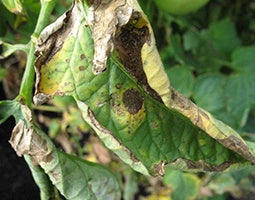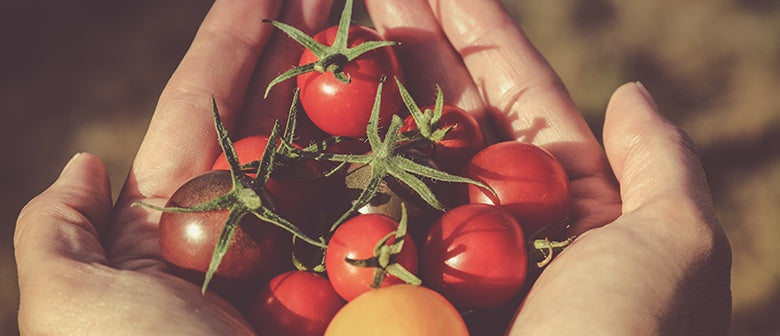Tomato Troubleshooting
Home-grown tomatoes are a source of pride, a thing of beauty, and beyond-description delicious. Whether heirlooms of the sort our grandmothers knew or a sweet cherry tomato treat, a perfect tomato is an achievement.
To produce that perfect tomato, be alert. Keep an eye on your plant’s health, look for larvae and other insects, watch for signs of disease
Weather or nutrient related problems
Leaf Curl

This can be caused by fluctuating temperatures. Use mulch to help regulate the soil temperature.
Magnesium Deficiency

The plants leaves are yellow between the veins. Give your tomato plant a good feed with Tui Tomato Food. If the problem persists, supplement the feed with Epsom Salts.
Blossom-End Rot

Caused by a calcium deficiency or rapid ripening from overwatering. Implement a regular watering schedule while the plants are growing. Gypsum can help to promote calcium and mulch can help with water retention.
Tomato Fruit Splitting

Usually a result of the changes in water. Tomatoes become familiar with the amount of water they receive; when waterings are increased this can cause a growth spurt. The fleshy fruit tissue grows at a faster rate than the skin, causing splitting. Although still edible, splits in the skin can make your plant more susceptible to viruses. Larger varieties like beefsteak are less susceptible to skin splitting.
Green Tomato Tops

Caused by excess sunlight, being too dry or too much potash. Apply Sulphate of Ammonia and water.
Sun Scald

Will appear as brown patches on the fruit and is caused by exposure to bright sunlight. You can leave some of the older, larger leaves on the plant to act as a sunshade to the fruit.
Blotchy Fruit

This can be caused by a few things; your tomato plants could be receiving too much heat, too much water, or not enough potash. Give your plants a feed of Tui Tomato Food – if the problem persists, feed with Tui Sulphate of Potash.
Fungus
Early Blight

Small spots appear on older leaves and dark mould present. Common in warmer weather. Spray regularly with copper and dispose of any affected leaves.
Late Blight

Will appear as irregular brown patches on leaves. More serious in wet, humid climates, use Yates Liquid Copper Fungicide Concentrate and dispose of affected
plants.
Powdery Mildew

A white grey powdery appearance to leaves, stems and fruit. Spray with Yates Nature’s Way Fungus Spray.
Botrytis/Grey Mould

Tomatoes and the plants leaves and stems develop a grey or brown rot or mould. Spray with Yates Liquid Copper Fungicide Concentrate.
Leaf Mould

Older leaf undersides have yellow blotches and show yellowing blotches with grey mould. Younger leaves may have pale circular spots. Spray with Yates Nature’s Way Fungus Spray.
Verticillium Wilt/Bacterial Wilt

Withering or dying leaves. Do not grow tomatoes in the same area for more than one year in three.
Pests
Aphids

Small insects that appear in clusters on the underside of leaves or on stems, sucking the sap from them. They cause plants to wilt and the leaves to pucker and distort. Treat with Yates Mavrik or Yates Nature’s Way Citrus and Ornamental Spray.
Mites

Minute insects that live on the underside of leaves. Your plant’s leaves will look yellow and dehydrated. Treat with Yates Mavrik or Yates Nature’s Way Citrus and Ornamental Spray.
Tomato Psyllid

The tiny psyllid can ruin your precious crop, they transfer a bacterial disease called Liberibacter. Infected plants show sudden signs of decline including yellowing or distorted leaves and may die. Spray with Yates Success Ultra Insect Control Spray.
Whitefly

Tiny white sap sucking insects that you will find on the undersides of the leaves. Treat with Yates Mavrik or Yates Nature’s Way Citrus and Ornamental Spray.
































